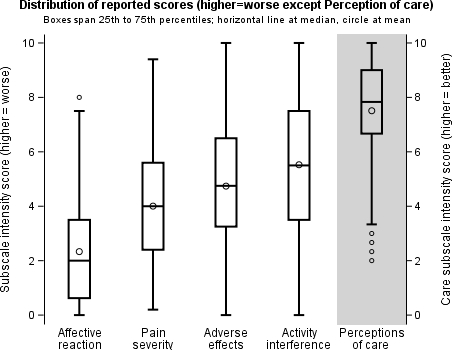Quality of Postoperative Pain Care in Living Liver Donors.
M. Mandell,1 A. Smith,2,6 D. Gordon,3 S. Holtzman,4 M. Dew,5 T. Howell,6 A. DiMartini,5 Z. Butt,8 M. Simpson,7 C. Freise,9 S. McCluskey,10 R. Fisher,11 J. Guaerra,12 K. Olthoff,13 E. Pomfret.7
1U of Colorado, Denver
2Arbor Research Collaborative for Health, Ann Arbor
3U of Washington, Seattle
4U of British Columbia, Okanagan, Canada
5U of Pittsburgh, Pittsburgh
6U of Michigan, Ann Arbor
7Lahey, Burlington
8Northwestern U, Chicago
9U of California at San Francisco, San Francisco
10U of Toronto, Toronto, Canada
11Virginia Commonwealth U, Richmond
12Columbia U, New York
13U of Pennsylvania, Philadelphia.
Meeting: 2016 American Transplant Congress
Abstract number: A219
Keywords: Living-related liver donors, Pain
Session Information
Session Name: Poster Session A: Living Donor Liver Transplantation
Session Type: Poster Session
Date: Saturday, June 11, 2016
Session Time: 5:30pm-7:30pm
 Presentation Time: 5:30pm-7:30pm
Presentation Time: 5:30pm-7:30pm
Location: Halls C&D
Background: Postoperative pain (POP) is the strongest predictor of chronic pain syndromes (Katz and Seltzer, Expert Rev Neurother 2009), however little is known about POP in living liver donors (LLD) beyond single center studies. The purpose of our study was to collect information reflecting the complex nature of the pain experience in LLD to design effective management strategies.
Methods: We collected prospective, observational data from 172 LLDs at nine A2ALL centers using a validated pain survey tool 48 hours after surgery that quantified five classes of outcomes shown in Fig 1 (Gordon et al, J of Pain, 2010). Results are on a 1-10 scale describing intensity of symptoms; linear mixed models were used to identify predictors of scores. Parameters of care and patient background characteristics were collected.
Results: Common pain management techniques were intravenous patient-controlled analgesia (76%), transversus abdominal pain block (36%) and epidural (17%). More than half of LLD reported pain scores greater than national guidelines. Adverse effects and activity interference were rated as more intense than pain severity. Female LLD had significantly higher negative emotional reaction to pain (Affective) and adverse effects of pain (Adverse Effects) than males, while those who participated in their pain management and on single pain therapy had higher perceptions of care.
Female LLD had significantly higher negative emotional reaction to pain (Affective) and adverse effects of pain (Adverse Effects) than males, while those who participated in their pain management and on single pain therapy had higher perceptions of care.
Conclusion: Most LLD had high perceptions of care; however the areas of pain severity, interference with function and adverse effects are targets for quality improvement.
CITATION INFORMATION: Mandell M, Smith A, Gordon D, Holtzman S, Dew M, Howell T, DiMartini A, Butt Z, Simpson M, Freise C, McCluskey S, Fisher R, Guaerra J, Olthoff K, Pomfret E. Quality of Postoperative Pain Care in Living Liver Donors. Am J Transplant. 2016;16 (suppl 3).
To cite this abstract in AMA style:
Mandell M, Smith A, Gordon D, Holtzman S, Dew M, Howell T, DiMartini A, Butt Z, Simpson M, Freise C, McCluskey S, Fisher R, Guaerra J, Olthoff K, Pomfret E. Quality of Postoperative Pain Care in Living Liver Donors. [abstract]. Am J Transplant. 2016; 16 (suppl 3). https://atcmeetingabstracts.com/abstract/quality-of-postoperative-pain-care-in-living-liver-donors/. Accessed January 6, 2026.« Back to 2016 American Transplant Congress
